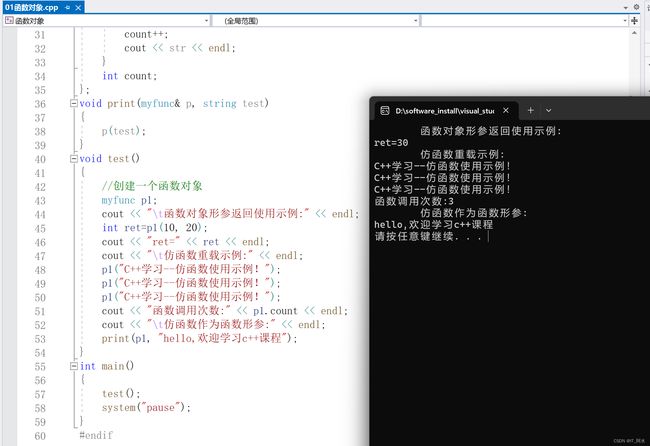- FPGA设计怎么学?薪资前景好吗?
博览鸿蒙
FPGAfpga开发
FPGA前端设计和各岗位之间有着很多联系,是一个薪资待遇高,前景发展好的岗位。但这个岗位的门槛也比较高,很多人不知道怎么学习,下面就和宸极教育一起来了解一下吧。数字前端设计必备技能1、熟悉数字电路设计2、熟悉Verilog或VHDL3、熟悉异步电路设计4、熟悉FIFO的设计5、熟悉UNIX系统及其工具的使用6、熟悉脚本语言Perl、Shell、Tcl等7、熟悉C/C++语言、SystemVeril
- PHP 安全与加密:守护 Web 应用的基石
来恩1003
PHP从入门到精通php安全前端
PHP学习资料PHP学习资料PHP学习资料在当今数字化时代,Web应用无处不在,而PHP作为一种广泛使用的服务器端脚本语言,承载着无数网站和应用的核心逻辑。然而,随着网络攻击手段日益复杂,PHP应用面临着诸多安全威胁,如SQL注入、XSS攻击等,同时,数据的加密保护也至关重要。本文将深入探讨PHP中的安全问题及加密算法的应用,帮助开发者构建更安全可靠的Web应用。一、PHP安全之殇——SQL注入攻
- C++ 一篇读懂“值传递”和“地址传递”
xzal12
C++c++
让我们通过一个简单的、形象的比喻来帮助你理解“值传递”和“地址传递”是如何影响实参的。1.值传递想象你有一个**信封**(代表变量),里面放着一张纸条(代表数据)。你决定把这个信封寄给一个朋友,让他们看一下纸条的内容。-**过程**:你把信封寄给朋友,但你实际上给朋友的是一个**副本**,也就是你将信封和纸条的内容完全复制了一份。-**结果**:你的朋友可以看到纸条上的内容,但他们修改纸条内容时,
- C++ 给数组整体(批量)赋值
xzal12
C++c++
1、memset函数给数组按字节赋值为内存做初始化工作需要头文件#include(1)给char类型数组按字节赋值,其中char占一个字节(2)int类型数组按字节赋值0和1,其中int占4个字节=4*8位eg1:memset(a,0,sizeof(a));//将a数组所有元素均赋值为0eg2:memset(b,1,sizeof(b));//将b数组所有元素均赋值为二进制数2^0+2^8+2^16
- 基于数据挖掘的股票预测系统
AI天才研究院
AI大模型企业级应用开发实战DeepSeekR1&大数据AI人工智能大模型计算科学神经计算深度学习神经网络大数据人工智能大型语言模型AIAGILLMJavaPython架构设计AgentRPA
1.背景介绍1.1股票市场预测的挑战股票市场以其波动性和不可预测性而闻名。无数因素,从全球经济趋势到个别公司公告,都会影响股票价格。这使得准确预测股票价格极具挑战性,即使对经验丰富的投资者和金融分析师也是如此。1.2数据挖掘的兴起近年来,数据挖掘技术的出现为股票预测提供了新的可能性。数据挖掘是从大型数据集中提取有意义的模式和洞察力的过程。通过利用先进的算法和计算能力,数据挖掘可以揭示隐藏在海量金融
- 深入解析 C++ STL中的 std::map 容器
金外飞176
C++开发语言c++
深入解析C++中的std::map容器在C++标准模板库(STL)中,std::map是一种非常强大且常用的关联式容器。它通过键值对(key-value)的方式存储数据,并且基于红黑树实现,能够高效地进行插入、删除和查找操作。本文将通过一个实际的项目代码,深入探讨std::map的各种特性,包括构造、插入、删除、查找、排序以及与其他容器的交互。1.std::map的基本概念std::map是一个关
- Java 与设计模式(15):模板方法模式
暗星涌动
设计模式java设计模式模板方法模式springboot
一、定义模板方法模式是一种行为设计模式,它定义了一个操作中的算法的骨架(也就是大致的步骤和流程),而将一些具体步骤的实现延迟到子类中。这样,子类可以不改变算法的结构即可重新定义算法的某些特定步骤。二、Java示例举个简单的例子:假设我们要泡一杯茶和一杯咖啡,这两者的制作过程有一些共同的步骤,比如烧水、倒水、搅拌等,但也有不同的地方,比如茶需要放茶叶,而咖啡需要放咖啡粉。泡茶的过程:烧水、放茶叶、倒
- js的垃圾回收机制
www.www
JavaScript相关javascript前端开发语言
js中的垃圾回收机制JavaScript作为一种高级语言,开发者不需要手动管理内存的分配和释放。垃圾回收机制是JavaScript引擎中的一部分,负责自动回收那些不再被使用的内存,确保内存资源得到有效利用,避免内存泄漏。垃圾回收机制主要有两种算法:引用计数和标记清除引用计数基本原理:每个对象都有一个引用计数器,当有一个引用指向该对象时,计数器+1,当一个引用不再指向该对象时,计数器-1。如果某个对
- 一文读懂MUSIC算法DOA估计的数学原理并仿真
迎风打盹儿
阵列信号处理MUSIC算法DOA估计阵列信号处理信号子空间噪声子空间
一文读懂MUSIC算法DOA估计的数学原理并仿真文章目录前言一、DOA估计基本原理二、MATLAB仿真总结前言MUSIC(MultipleSignalClassification)算法于1979年由R.O.Schmidt提出,是阵列信号处理中广泛应用的经典DOA(DirectionofArrival)估计算法,凭借其超分辨的估计性能受到广泛关注。本文将从数学公式推导的角度出发系统阐述MUSIC算法
- 排序算法:冒泡排序(Python)
娱乐不打烊丶
排序算法算法数据结构
思路:大家一定都喝过汽水吧,汽水中常常有许多小小的气泡,往上飘,这是因为组成小气泡的二氧化碳比水要轻,所以小气泡才会一点一点的向上浮。而冒泡排序之所以叫冒泡排序,正是因为这种排序算法的每一个元素都可以向小气泡一样,根据自身大小,一点一点向着数组的一侧移动。一图解百惑,上图!那么,话不多说,上代码!defbubble_sort(input_list):#冒泡排序:每次循环,锁定一个最值,并朝着最大或
- 【深度学习目标检测|YOLO算法5-1-1】YOLO家族进化史:从YOLOv1到YOLOv11的架构创新、性能优化与行业应用全解析...
985小水博一枚呀
论文解读深度学习目标检测YOLO人工智能算法架构网络
【深度学习目标检测|YOLO算法5-1-1】YOLO家族进化史:从YOLOv1到YOLOv11的架构创新、性能优化与行业应用全解析…【深度学习目标检测|YOLO算法5-1-1】YOLO家族进化史:从YOLOv1到YOLOv11的架构创新、性能优化与行业应用全解析…文章目录【深度学习目标检测|YOLO算法5-1-1】YOLO家族进化史:从YOLOv1到YOLOv11的架构创新、性能优化与行业应用全解
- 基于MUSIC算法的DOA估计Matlab仿真
fpga和matlab
★MATLAB算法仿真经验板块1:通信与信号处理matlabMUSIC算法DOA估计
up目录一、理论基础二、核心程序三、测试结果一、理论基础阵列信号处理是信号处理领域内的一个重要分支,在近些年来得到了迅速发展。波达方向(DirectionofArrival,DOA)估计是阵列信号处理的一个重要的研究领域,在雷达、通信、声纳、地震学等领域都有着广泛的应用前景。在DOA估计的发展过程中,人们对高分辨DOA估计算法一直有很大的研究兴趣,并在这一领域取得了很多重要的进展。阵列信号处理主要
- c和c++的区别是
Utopia.️
c++
digitalRead处理的是数字信号,只能返回HIGH或LOW。analogRead处理的是模拟信号,将模拟电压值转换为10位数字值(0到1023),可以用来测量电压的实际值或模拟信号的强度。c和c++的区别是C和C++是两种编程语言,它们有许多共同点,但也有重要的区别。以下是它们的主要区别:1.语言类型C:是一种过程式编程语言。程序的执行依赖于函数和过程,代码是按顺序执行的。C++:是一种面向
- (九万字)面向2025年BOSS直聘人工智能算法工程师高频面试题解析
快撑死的鱼
人工智能回归pythonpytorch
面向2025年BOSS直聘人工智能算法工程师高频面试题解析1.机器学习(ML)理论解析机器学习是让计算机从数据中学习规律的一套方法论,包含监督学习、无监督学习和强化学习等范式。在监督学习中,给定带标签的数据,算法尝试学习从输入到输出的映射关系;无监督学习则在缺乏标签的情况下挖掘数据内在结构;强化学习则让智能体通过与环境交互、依据奖赏反馈来改进策略(Q-learning-Wikipedia)。机器学
- 人工智能与机器学习入门:基尼系数(Gini Index)和基于熵(Entropy)
基尼系数基于熵机器学习入门
在决策树应用一文中,在构建决策分类树应用决策算法时,介绍了基尼系数(GiniIndex)和基于熵(Entropy)两种算法。本文通过实例来更加深入的介绍一下这两个算法。仍然以简单的数据为例:id喜欢颜色是否有喉结身高性别1绿否165女2蓝是170男3粉否172女4绿是175男基尼系数分别对喜欢颜色是否有喉结求基尼系数如下:喜欢的颜色id喜欢颜色性别1绿女2蓝男3粉女4绿男对于姓别女分类而言,数据如
- java 实现TextRank算法提取文章摘要
melck
java算法开发语言
在Java中,常用的文章摘要提取库是“TextRank”算法。该算法从文本中提取主题和段落,并根据主题和文本中的单词计算权重。使用TextRank实现文章摘要提取具体步骤如下:寻找文章中的关键句子:首先需要分割出文章中的句子,可以使用分词库将文章拆分成句子,然后使用TextRank算法找到文章中与主题相关的句子,这些句子通常包含有标题、关键字等。计算句子的权重:针对关键句子,需要对每个句子计算权重
- 图论篇--代码随想录算法训练营第五十七天打卡| 最小生成树问题
無量空所
leetcode算法图论数据结构c++学习
题目链接:53.寻宝(第七期模拟笔试)题目描述:在世界的某个区域,有一些分散的神秘岛屿,每个岛屿上都有一种珍稀的资源或者宝藏。国王打算在这些岛屿上建公路,方便运输。不同岛屿之间,路途距离不同,国王希望你可以规划建公路的方案,如何可以以最短的总公路距离将所有岛屿联通起来(注意:这是一个无向图)。给定一张地图,其中包括了所有的岛屿,以及它们之间的距离。以最小化公路建设长度,确保可以链接到所有岛屿。解题
- DeepSeek 赋能工业软件之全流程方案
爱吃青菜的大力水手
人工智能自动化持续部署语言模型开源
deepseek赋能工业软件之全流程方案之侧重半导体FABdeepseek在工业软件中的应用场景“deepseek”大模型在工业软件领域拥有广泛的应用场景,包括以下几个方面:智能调度:利用深度学习和优化算法,根据实时数据动态调整生产计划和资源分配。它可以综合考虑订单需求、设备状态和产能限制,智能生成最优的生产排程方案,减少等待时间和切换成本。例如在汽车制造工厂,deepseek可根据订单需求和设备
- 动态规划之背包问题的Python实现
名侦探debug
Python数据结构python数据结构动态规划求解
目录1.问题描述2.动态规划之网格法3.python实现1.问题描述题目来源于《算法图解》第9章练习题9.2,如下图所示。对于背包问题,通常的做法有列举法、贪婪算法和动态规划(1)列举法:列举出所有的可能情况,再选择最优解,但当情况很多时,这种算法复杂度很高(2)贪婪算法:在容量允许范围内,每次都拿剩余物品中价值最高的,贪婪算法能够快速解决复杂度很高的问题,但通常得到的是次优解,但就对这个题目而言
- 数据挖掘十大经典算法详解(附原理解析与代码示例)
IT程序媛-桃子
华为认证数据挖掘算法经验分享华为
1.PageRank(链接分析)应用场景:搜索引擎排名、社交网络分析核心原理PageRank通过网页之间的链接关系计算网页的重要性,影响力大的网页排名更高。网页影响力=所有入链页面的加权影响力之和阻尼因子D(通常设为0.85)用于模拟用户随机访问网页的行为代码示例importnetworkxasnxG=nx.DiGraph()G.add_edges_from([("A","B"),("A","C"
- 【练习】【二分】力扣热题100 34. 在排序数组中查找元素的第一个和最后一个位置
柠石榴
输入输出力扣hot100leetcode算法c++二分
题目给你一个按照非递减顺序排列的整数数组nums,和一个目标值target。请你找出给定目标值在数组中的开始位置和结束位置。如果数组中不存在目标值target,返回[-1,-1]。你必须设计并实现时间复杂度为O(logn)的算法解决此问题。示例1:输入:nums=[5,7,7,8,8,10],target=8输出:[3,4]示例2:输入:nums=[5,7,7,8,8,10],target=6输出
- 动态规划之背包问题
于冬恋
动态规划算法
动态规划是一个重要的算法范式,它将一个问题分解为一系列更小的子问题,并通过存储子问题的解来避免重复计算,从而大幅提升时间效率。目录01背包问题完全背包问题多重背包问题二维费用背包问题(1)01背包问题给定n个物体,和一个容量为c的背包,物品i的重量为wi,其价值为应该如何选择装入背包的物品使其获得的总价值最大。可以用贪心算法,但是不一定能达到最优解,所以用动态规划解决创建一个数组dp[i][j]i
- 在瑞芯微RK3588平台上使用RKNN部署YOLOv8Pose模型的C++实战指南
机 _ 长
YOLO系列模型有效涨点改进深度学习落地实战YOLOc++开发语言
在人工智能和计算机视觉领域,人体姿态估计是一项极具挑战性的任务,它对于理解人类行为、增强人机交互等方面具有重要意义。YOLOv8Pose作为YOLO系列中的新成员,以其高效和准确性在人体姿态估计任务中脱颖而出。本文将详细介绍如何在瑞芯微RK3588平台上,使用RKNN(RockchipNeuralNetworkToolkit)框架部署YOLOv8Pose模型,并进行C++代码的编译和运行。注本文全
- 十大排序算法
myprogramc
排序算法算法数据结构
排序算法插入排序冒泡排序选择排序希尔排序计数排序快速排序1经典Lomuto分区法2经典Lomuto分区法3随机快排堆排序归并排序桶排序基数排序插入排序从i=1开始,判断nums[i-1]和nums[i]的大小,一直到nums[i]插入到自己的位置。模拟抓扑克牌的过程:将元素插入到已排序的部分,使其有序voidinsertionSort(vector&nums){for(inti=1;i=0&&nu
- 【CUDA】Pytorch_Extensions
joker D888
深度学习pytorchpythoncudac++深度学习
【CUDA】Pytorch_Extensions为什么要开发CUDA扩展?当我们在PyTorch中实现自定义算子时,通常有两种选择:使用纯Python实现(简单但效率低)使用C++/CUDA扩展(高效但需要编译)对于计算密集型的操作(如神经网络中的自定义激活函数),使用CUDA扩展可以获得接近硬件极限的性能。本文将以实现一个多项式激活函数x²+x+1为例,展示完整的开发流程。完整CUDA扩展代码解
- 侯捷 C++ 课程学习笔记:C++ 面向对象开发的艺术
孤寂大仙v
c++c++学习笔记
在侯捷老师的C++系列课程中,《C++面向对象开发》这门课程让我对面向对象编程有了更深入的理解。面向对象编程(OOP)是现代软件开发中最重要的编程范式之一,而C++作为支持OOP的语言,提供了强大的工具和特性。侯捷老师通过系统的讲解和实战案例,帮助我掌握了如何在C++中高效地使用面向对象技术。以下是我对这门课程的学习笔记和心得体会。一、课程核心内容:C++面向对象开发的关键特性![侯捷老师的课程详
- 使用Python和OpenCV实现图像像素压缩与解压
东方佑
量子变法pythonopencv开发语言
在本文中,我们将探讨如何使用Python和OpenCV库来实现一种简单的图像像素压缩算法。我们将详细讨论代码的工作原理,并提供一个具体的示例来演示该过程。1.引言随着数字媒体的普及,图像处理成为了一个重要的领域。无论是为了减少存储空间还是加快网络传输速度,图像压缩技术都扮演着至关重要的角色。这里,我们提出了一种基于像素重复模式的简单压缩算法,它适用于具有大量连续相同像素值的图像。2.技术栈介绍2.
- DeepSeek如何重塑我的编程学习:计算机新生的AI实践
EnigmaCoder
DeepSeek学习人工智能
目录前言邂逅DeepSeek:从困惑到惊喜初学编程的困境DeepSeek的优势️DeepSeek在编程学习中的运用注释算法逐步分析调试帮助跨语言迁移学习AI时代学习方法论革新知识获取方式转变新型学习能力培养反思与展望反思展望总结前言大家好!我是EnigmaCoder,本文我将介绍我的AI编程学习之旅。春节期间,DeepSeek横空出世,迅速登顶热榜。它功能强大,精准答疑、高效创作,瞬间点燃大众热情
- 鸢尾花分类项目 GUI
编织幻境的妖
分类数据挖掘人工智能
1.机器学习的定义机器学习是一门人工智能的分支,专注于开发算法和统计模型,使计算机能够在没有明确编程的情况下从数据中自动学习和改进。通过识别数据中的模式和规律,机器学习系统可以做出预测或决策。常见的应用包括图像识别、语音识别、推荐系统等。2.为什么使用鸢尾花数据集(Irisdataset)鸢尾花数据集是一个经典的多类分类问题数据集,由英国统计学家和遗传学家RonaldFisher在1936年引入。
- 改进YOLO系列 | YOLOv5/v7 引入 Dynamic Snake Convolution | 动态蛇形卷积
wei子
YOLO目标跟踪人工智能
改进YOLO系列:动态蛇形卷积(DynamicSnakeConvolution,DSC)简介YOLO系列目标检测算法以其速度和精度著称,但对于细长目标例如血管、道路等,其性能仍有提升空间。动态蛇形卷积(DSC)是YOLOv5/v7中引入的一种改进,旨在更好地处理细长目标。DSC原理DSC的核心思想是使用类似蛇形运动的卷积核来提取细长目标的特征。具体来说,DSC卷积核沿着一系列控制点移动,并根据每个
- Spring4.1新特性——综述
jinnianshilongnian
spring 4.1
目录
Spring4.1新特性——综述
Spring4.1新特性——Spring核心部分及其他
Spring4.1新特性——Spring缓存框架增强
Spring4.1新特性——异步调用和事件机制的异常处理
Spring4.1新特性——数据库集成测试脚本初始化
Spring4.1新特性——Spring MVC增强
Spring4.1新特性——页面自动化测试框架Spring MVC T
- Schema与数据类型优化
annan211
数据结构mysql
目前商城的数据库设计真是一塌糊涂,表堆叠让人不忍直视,无脑的架构师,说了也不听。
在数据库设计之初,就应该仔细揣摩可能会有哪些查询,有没有更复杂的查询,而不是仅仅突出
很表面的业务需求,这样做会让你的数据库性能成倍提高,当然,丑陋的架构师是不会这样去考虑问题的。
选择优化的数据类型
1 更小的通常更好
更小的数据类型通常更快,因为他们占用更少的磁盘、内存和cpu缓存,
- 第一节 HTML概要学习
chenke
htmlWebcss
第一节 HTML概要学习
1. 什么是HTML
HTML是英文Hyper Text Mark-up Language(超文本标记语言)的缩写,它规定了自己的语法规则,用来表示比“文本”更丰富的意义,比如图片,表格,链接等。浏览器(IE,FireFox等)软件知道HTML语言的语法,可以用来查看HTML文档。目前互联网上的绝大部分网页都是使用HTML编写的。
打开记事本 输入一下内
- MyEclipse里部分习惯的更改
Array_06
eclipse
继续补充中----------------------
1.更改自己合适快捷键windows-->prefences-->java-->editor-->Content Assist-->
Activation triggers for java的右侧“.”就可以改变常用的快捷键
选中 Text
- 近一个月的面试总结
cugfy
面试
本文是在学习中的总结,欢迎转载但请注明出处:http://blog.csdn.net/pistolove/article/details/46753275
前言
打算换个工作,近一个月面试了不少的公司,下面将一些面试经验和思考分享给大家。另外校招也快要开始了,为在校的学生提供一些经验供参考,希望都能找到满意的工作。
- HTML5一个小迷宫游戏
357029540
html5
通过《HTML5游戏开发》摘抄了一个小迷宫游戏,感觉还不错,可以画画,写字,把摘抄的代码放上来分享下,喜欢的同学可以拿来玩玩!
<html>
<head>
<title>创建运行迷宫</title>
<script type="text/javascript"
- 10步教你上传githib数据
张亚雄
git
官方的教学还有其他博客里教的都是给懂的人说得,对已我们这样对我大菜鸟只能这么来锻炼,下面先不玩什么深奥的,先暂时用着10步干净利索。等玩顺溜了再用其他的方法。
操作过程(查看本目录下有哪些文件NO.1)ls
(跳转到子目录NO.2)cd+空格+目录
(继续NO.3)ls
(匹配到子目录NO.4)cd+ 目录首写字母+tab键+(首写字母“直到你所用文件根就不再按TAB键了”)
(查看文件
- MongoDB常用操作命令大全
adminjun
mongodb操作命令
成功启动MongoDB后,再打开一个命令行窗口输入mongo,就可以进行数据库的一些操作。输入help可以看到基本操作命令,只是MongoDB没有创建数据库的命令,但有类似的命令 如:如果你想创建一个“myTest”的数据库,先运行use myTest命令,之后就做一些操作(如:db.createCollection('user')),这样就可以创建一个名叫“myTest”的数据库。
一
- bat调用jar包并传入多个参数
aijuans
下面的主程序是通过eclipse写的:
1.在Main函数接收bat文件传递的参数(String[] args)
如: String ip =args[0]; String user=args[1]; &nbs
- Java中对类的主动引用和被动引用
ayaoxinchao
java主动引用对类的引用被动引用类初始化
在Java代码中,有些类看上去初始化了,但其实没有。例如定义一定长度某一类型的数组,看上去数组中所有的元素已经被初始化,实际上一个都没有。对于类的初始化,虚拟机规范严格规定了只有对该类进行主动引用时,才会触发。而除此之外的所有引用方式称之为对类的被动引用,不会触发类的初始化。虚拟机规范严格地规定了有且仅有四种情况是对类的主动引用,即必须立即对类进行初始化。四种情况如下:1.遇到ne
- 导出数据库 提示 outfile disabled
BigBird2012
mysql
在windows控制台下,登陆mysql,备份数据库:
mysql>mysqldump -u root -p test test > D:\test.sql
使用命令 mysqldump 格式如下: mysqldump -u root -p *** DBNAME > E:\\test.sql。
注意:执行该命令的时候不要进入mysql的控制台再使用,这样会报
- Javascript 中的 && 和 ||
bijian1013
JavaScript&&||
准备两个对象用于下面的讨论
var alice = {
name: "alice",
toString: function () {
return this.name;
}
}
var smith = {
name: "smith",
- [Zookeeper学习笔记之四]Zookeeper Client Library会话重建
bit1129
zookeeper
为了说明问题,先来看个简单的示例代码:
package com.tom.zookeeper.book;
import com.tom.Host;
import org.apache.zookeeper.WatchedEvent;
import org.apache.zookeeper.ZooKeeper;
import org.apache.zookeeper.Wat
- 【Scala十一】Scala核心五:case模式匹配
bit1129
scala
package spark.examples.scala.grammars.caseclasses
object CaseClass_Test00 {
def simpleMatch(arg: Any) = arg match {
case v: Int => "This is an Int"
case v: (Int, String)
- 运维的一些面试题
yuxianhua
linux
1、Linux挂载Winodws共享文件夹
mount -t cifs //1.1.1.254/ok /var/tmp/share/ -o username=administrator,password=yourpass
或
mount -t cifs -o username=xxx,password=xxxx //1.1.1.1/a /win
- Java lang包-Boolean
BrokenDreams
boolean
Boolean类是Java中基本类型boolean的包装类。这个类比较简单,直接看源代码吧。
public final class Boolean implements java.io.Serializable,
- 读《研磨设计模式》-代码笔记-命令模式-Command
bylijinnan
java设计模式
声明: 本文只为方便我个人查阅和理解,详细的分析以及源代码请移步 原作者的博客http://chjavach.iteye.com/
import java.util.ArrayList;
import java.util.Collection;
import java.util.List;
/**
* GOF 在《设计模式》一书中阐述命令模式的意图:“将一个请求封装
- matlab下GPU编程笔记
cherishLC
matlab
不多说,直接上代码
gpuDevice % 查看系统中的gpu,,其中的DeviceSupported会给出matlab支持的GPU个数。
g=gpuDevice(1); %会清空 GPU 1中的所有数据,,将GPU1 设为当前GPU
reset(g) %也可以清空GPU中数据。
a=1;
a=gpuArray(a); %将a从CPU移到GPU中
onGP
- SVN安装过程
crabdave
SVN
SVN安装过程
subversion-1.6.12
./configure --prefix=/usr/local/subversion --with-apxs=/usr/local/apache2/bin/apxs --with-apr=/usr/local/apr --with-apr-util=/usr/local/apr --with-openssl=/
- sql 行列转换
daizj
sql行列转换行转列列转行
行转列的思想是通过case when 来实现
列转行的思想是通过union all 来实现
下面具体例子:
假设有张学生成绩表(tb)如下:
Name Subject Result
张三 语文 74
张三 数学 83
张三 物理 93
李四 语文 74
李四 数学 84
李四 物理 94
*/
/*
想变成
姓名 &
- MySQL--主从配置
dcj3sjt126com
mysql
linux下的mysql主从配置: 说明:由于MySQL不同版本之间的(二进制日志)binlog格式可能会不一样,因此最好的搭配组合是Master的MySQL版本和Slave的版本相同或者更低, Master的版本肯定不能高于Slave版本。(版本向下兼容)
mysql1 : 192.168.100.1 //master mysq
- 关于yii 数据库添加新字段之后model类的修改
dcj3sjt126com
Model
rules:
array('新字段','safe','on'=>'search')
1、array('新字段', 'safe')//这个如果是要用户输入的话,要加一下,
2、array('新字段', 'numerical'),//如果是数字的话
3、array('新字段', 'length', 'max'=>100),//如果是文本
1、2、3适当的最少要加一条,新字段才会被
- sublime text3 中文乱码解决
dyy_gusi
Sublime Text
sublime text3中文乱码解决
原因:缺少转换为UTF-8的插件
目的:安装ConvertToUTF8插件包
第一步:安装能自动安装插件的插件,百度“Codecs33”,然后按照步骤可以得到以下一段代码:
import urllib.request,os,hashlib; h = 'eb2297e1a458f27d836c04bb0cbaf282' + 'd0e7a30980927
- 概念了解:CGI,FastCGI,PHP-CGI与PHP-FPM
geeksun
PHP
CGI
CGI全称是“公共网关接口”(Common Gateway Interface),HTTP服务器与你的或其它机器上的程序进行“交谈”的一种工具,其程序须运行在网络服务器上。
CGI可以用任何一种语言编写,只要这种语言具有标准输入、输出和环境变量。如php,perl,tcl等。 FastCGI
FastCGI像是一个常驻(long-live)型的CGI,它可以一直执行着,只要激活后,不
- Git push 报错 "error: failed to push some refs to " 解决
hongtoushizi
git
Git push 报错 "error: failed to push some refs to " .
此问题出现的原因是:由于远程仓库中代码版本与本地不一致冲突导致的。
由于我在第一次git pull --rebase 代码后,准备push的时候,有别人往线上又提交了代码。所以出现此问题。
解决方案:
1: git pull
2:
- 第四章 Lua模块开发
jinnianshilongnian
nginxlua
在实际开发中,不可能把所有代码写到一个大而全的lua文件中,需要进行分模块开发;而且模块化是高性能Lua应用的关键。使用require第一次导入模块后,所有Nginx 进程全局共享模块的数据和代码,每个Worker进程需要时会得到此模块的一个副本(Copy-On-Write),即模块可以认为是每Worker进程共享而不是每Nginx Server共享;另外注意之前我们使用init_by_lua中初
- java.lang.reflect.Proxy
liyonghui160com
1.简介
Proxy 提供用于创建动态代理类和实例的静态方法
(1)动态代理类的属性
代理类是公共的、最终的,而不是抽象的
未指定代理类的非限定名称。但是,以字符串 "$Proxy" 开头的类名空间应该为代理类保留
代理类扩展 java.lang.reflect.Proxy
代理类会按同一顺序准确地实现其创建时指定的接口
- Java中getResourceAsStream的用法
pda158
java
1.Java中的getResourceAsStream有以下几种: 1. Class.getResourceAsStream(String path) : path 不以’/'开头时默认是从此类所在的包下取资源,以’/'开头则是从ClassPath根下获取。其只是通过path构造一个绝对路径,最终还是由ClassLoader获取资源。 2. Class.getClassLoader.get
- spring 包官方下载地址(非maven)
sinnk
spring
SPRING官方网站改版后,建议都是通过 Maven和Gradle下载,对不使用Maven和Gradle开发项目的,下载就非常麻烦,下给出Spring Framework jar官方直接下载路径:
http://repo.springsource.org/libs-release-local/org/springframework/spring/
s
- Oracle学习笔记(7) 开发PLSQL子程序和包
vipbooks
oraclesql编程
哈哈,清明节放假回去了一下,真是太好了,回家的感觉真好啊!现在又开始出差之旅了,又好久没有来了,今天继续Oracle的学习!
这是第七章的学习笔记,学习完第六章的动态SQL之后,开始要学习子程序和包的使用了……,希望大家能多给俺一些支持啊!
编程时使用的工具是PLSQL



